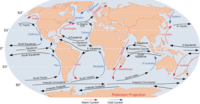
Photo from wikipedia
The increase in energy consumption that occurs in the residential sector implies a higher consumption of natural resources and, therefore, an increase in pollution and a degradation of the ecosystem.… Click to show full abstract
The increase in energy consumption that occurs in the residential sector implies a higher consumption of natural resources and, therefore, an increase in pollution and a degradation of the ecosystem. An optimal use of materials in the thermal envelope, together with efficient measures in the passive architectural design process, translate into lower energy demands in residential buildings. The objective of this study is to analyse and compare, through simulating different models, the impact of the shape factor on energy demand and CO2 emissions depending on the type of construction solution used in the envelope in a cold oceanic climate in South Chile. Five models with different geometries were considered based on their relationship between exposed surface and volume. Additionally, three construction solutions were chosen so that their thermal transmittance gradually complied with the values required by thermal regulations according to the climatic zone considered. Other parameters were equally established for all simulations so that their comparison was objective. Ninety case studies were obtained. Research has shown that an appropriate design, considering a shape factor suitable below 0.767 for the type of cold oceanic climate, implies a decrease in energy demand, which increased when considering architectural designs in the envelope with high values of thermal resistance.
Journal Title: Sustainability
Year Published: 2021
Link to full text (if available)
Share on Social Media: Sign Up to like & get
recommendations!